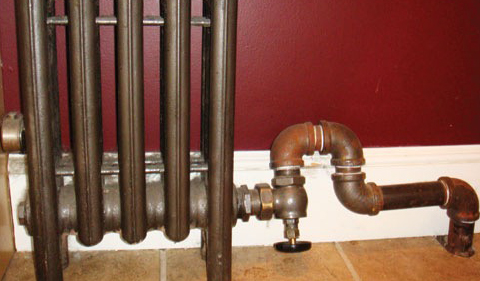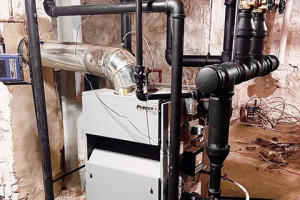
Hello, old friend. I’m writing today to say thanks, and to say farewell. This will be my last column.

How’s that for a title? I’ll give you the answer right up front: Everyone!
And the best part is you don’t have to know what you’re doing; you just have to show up. I promise there will be someone somewhere who will hire you no matter what. In the business of messing with old steam systems, there truly is a butt for every seat.
A wholesaler in Northern New Jersey once sent me a note to tell me a story his contractor customer had stopped by to tell him. Who gets to work on steam? Well, there’s the guy with the cheapest price of course. Here’s a great example of that:
“This contractor I’ve known for years just told me about a steam boiler he bid on but didn’t get,” my wholesaler friend said. “The lady listened to his price and then said she’d get back to him. A few weeks later, she calls him in a panic. He had to get over there right away. When he gets to her house, she points toward the basement. He goes down the stairs and straight into a steam bath. There was steam and condensate everywhere, and the pipes were sagging like wet noodles. He shut off the boiler and then realized that someone had piped the boiler with PVC pipe. Plastic pipe! On steam. We’re talking wet noodles here. Can you believe it?”
I told him that I could believe it because in America, everyone gets to work on steam.
“Yeah, that’s true,” my friend said.
“So what happened?”
“This is the best part. The contractor asked the lady why she hadn’t used him instead of the other guy in the first place. She could have gotten the job done right. Now, she was going to have to pay him to fix what she had already paid the other guy to screw up.”
“What did she say?”
“She told him she didn’t hire him because his price was a thousand bucks more. He asked her why she didn’t call the other guy back. She says the other guy isn’t answering her calls. And that’s when the contractor asked the lady if she ever wondered why the other guy was a thousand bucks cheaper. I can’t stop laughing!”
Neither can I. It’s been years since I heard that story and I’m still laughing.
My friend Moses Fishman of Brooklyn, New York fame is retired now, but when he was fixing countless steam systems, he came across a steam boiler in a basement that had an interesting accessory. It was an Extrol compression tank — an item you would expect to see on a hot-water boiler. But there it was, hanging off the side of the steam riser that ran between the steam boiler and the steam header. Steam doesn’t need an expansion tank, of course, so I asked Moses why anyone would do such a dopey thing.
“The building owner said the contractor told him the tank would cure the water hammer that was everywhere.”
“Huh?”
“Yes, the contractor said it was like a giant water-hammer arrestor. When the hammering tried to hammer, the rubber diaphragm inside the tank would act like a trampoline and cure the problem once and for all.”
“Who gets to work on steam in Brooklyn, Moses?”
“You know the answer to that, Dan,” Moses laughed. “Everybody!”
Another day, I’m walking through an office building where another of the everybodies had just added dozens of thermostatic radiator valves with remote sensors. He added them because the building had steam heat, and was hotter than a menopause convention. TRVs, when properly applied, generally do a nice job of keeping steam radiators from overheating.”
So, I’m walking from office to office with the person in charge of the building and seeing the same thing again and again. I’m also listening to the tenants tell me that it’s now too cold in their offices.
The problem was easy to spot. The remote sensor for every TRV was sitting between the first and second sections of cast-iron radiators. As soon as steam arrived, the TRV shut it off.
“It’s too cold now,” a secretary wearing a down coat said.
“Yep.”
Who else gets to work on steam heat? People who don’t read instructions.
And speaking of sensors, HeatTimer makes a very nice central controller for big steam systems. They’re in just about every large, steam-heated building. The controller turns on the boiler when the outdoor temperature drops below whatever temperature you choose. The boiler then makes steam, which travels out into the mains and risers. At some point in that piping network, which is going to be different in every building, someone has decided on the best location for the sensor. The sensor’s job is to wait until it feels heat and then shout back to the boiler room that steam has arrived at that location. This begins a countdown-to-shutoff of a certain amount of minutes. The length of the countdown will depend on how cold it is outside at that particular time. The colder it is, the longer the countdown.
Simple, right?
And where that person mounts that temperature sensor within that building is going to determine success or miserable failure? Ideally, the sensor should be near the end of the longest horizontal steam main in the basement. The challenge is, once mounted, the steam pipes get covered in insulation and nobody left a note letting future generations know where they buried the temperature-sensing treasure.
So you walk around and look. And what do you see? Well, I’ve seen those sensors installed on condensate-return lines. That’s a silly place for a steam-temperature sensor because the condensate in the return lines is never going to reach steam temperature and activate the sensor. That’s why we call it condensate. It’s condensed steam. It’s not as hot. So the burner runs 24/7 and the fuel bills soar. And why?
Well, you know why.
But wait; it gets better. Ask yourself this question: “Will a cold-water pipe for domestic water ever get to steam temperature?” Not unless the building is on fire, right? So why then, would somebody mount the sensor on that cold-water pipe? And why would someone strap the steam-temperature sensor to a natural gas line? When asked that question, the installer shrugged and told me they were trying to save gas.
Oh.
When I worked for the manufacturer's rep, we sold big boiler-feed pumps. A nice fella from the New York City Housing Authority asked me to take a look at one that was giving them fits. The mechanical seals kept leaking, and the pump wouldn’t pump properly.
When I got to the basement of this high-rise that was one of several, all taking heat from that central boiler room, I saw the troubled feed pump had a garden hose stuck down its air vent. The water was turned on full force. That was to cool the condensate so the pump would stop cavitating. There was water spewing from where the pump’s mechanical seal used to be. To keep people from getting soaked, someone had MacGyvered a sheet of rubber over the top of the pump to direct the gushing water toward a drain.
“What’s this?” I asked.
“The pump won’t pump right so that’s how we gotta do it. You guys make lousy pumps.”
“You’re using a garden hose,” I said.
“Yeah. It’s the only way we can keep the pump running so it can feed the boiler.”
“And you’re dumping all the condensate.”
“Yeah, it’s too hot.”
“When was the last time you serviced the steam traps?”
“We don’t do that,” he said.
“Who does?”
“Nobody. We don’t have the money for that.”
“So you have nothing but freshwater going into the boiler,” I said.
“Yeah, but we treat the water with chemicals.”
“Where do you add the chemicals?”
“Right into the vent hole.” He pointed at the feed pump’s tank. “Right there. We gotta take the hose out for a minute when we do it.”
“How much treatment do you use? Too much will kill mechanical seals.”
“Oh, we’re careful about that,” he said. “The chemical guy told us to use one measure a day.” He reached for the measuring cup. “This much.”
“Do you remember to do it every day?”
“Sometimes we forget,” he said.
“That’s not good.”
“I know,” he said. “That’s why we worked out a schedule for it. So we wouldn’t forget to do it every day, we add seven measures every Monday morning. Then we’re good for the whole week.” He nodded. Smiled. “That’s good, right?”
Who gets to work on steam?
Everybody!

Hello, old friend. I’m writing today to say thanks, and to say farewell. This will be my last column.

My six-year-old grandboy, Brendan, was in the vestibule of the diner when the bubblegum machine caught his attention. It was one of those spiral models that appeared in t...

Subdural posed a question on The Wall at HeatingHelp.com in the Strictly Steam section, where some of the sharpest knives in the drawer post every day. The question was a...